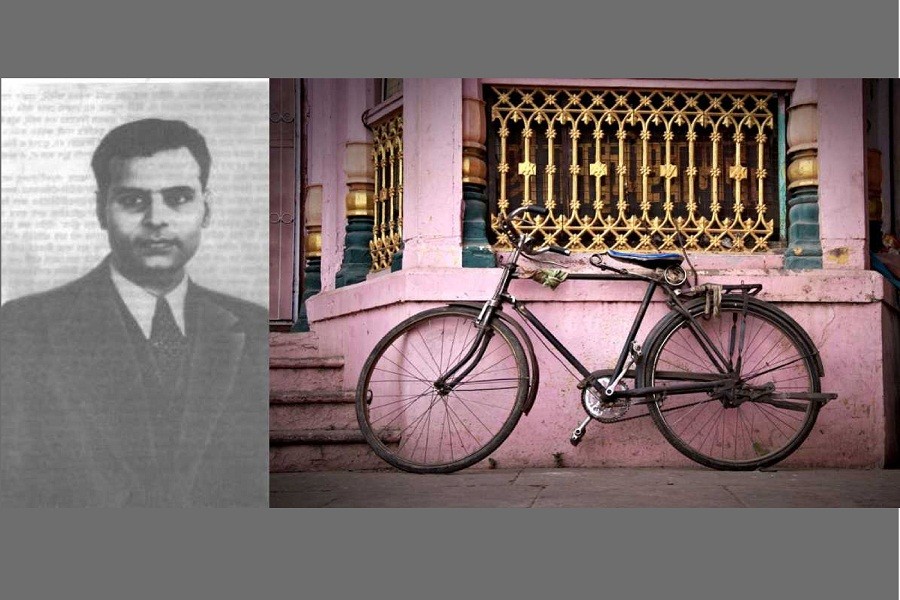The whole of Calcutta had gathered in the Town Hall on the lovely winter morning. People from all walks of life were celebrating the first Indian globe-trotter team. The four cyclists - Ashok Mukherjee, Bimal Mukherjee, Ananda Mukherjee and Manindra Ghosh would ride cycles to ride across the world for the first time any Indian had done so. Everyone used to read about the death-defying adventures of the white men in books and newspapers; never did anyone think any Indian, let alone a Bengali, would dare so. However, here they were, the four young Bengali men, moving out in the wide world on bicycles.
One of the men was Bimal Mukherjee, who had a penchant for writing down his journey. He had meticulously written down the tale of their glorious adventure and later published the story in his memoir 'Du Chakay Duniya,' published in 1978.
Bimal Mukherjee heard the call of the unknown in his youth. In 1924, he sought permission to join the Second Himalayan Expedition under Brigadier General Charles Bruce, the ill-fated expedition where two English mountaineers, George Mallory and Andrew 'Sandy' Irvine disappeared, which has given rise to the long-standing unanswered question of whether or not the pair climbed to the summit, but Mukherjee was denied.
The four cyclists rode across India, crossing Allahabad, Delhi to Karachi, where they took the ship to Basra and went to Iraq. From there, the four cyclists crossed the harsh desert with bedouins, experiencing near-death experiences due to dehydration and heat stroke. They travelled across Syria and Turkey and entered Europe.
Then began the most challenging part of the journey, as they had crossed the Bohemian Alps in bicycles wearing flannel shirts and no woollen clothing in the month of December. They went on through Bulgaria, Hungary, Yugoslavia and Austria, despite experiencing severe frostbite and hypothermia. They had kept warm by cycling vigorously and alternated keeping one hand in their pockets to prevent frostbite. Another problem arose when the Globe-Trotting Committee stopped sending money for them, plunging them into serious poverty. They had to live on by sharing a loaf of bread and coffee, and their health deteriorated. Only by the local Europeans' kindness did they survive and reach Berlin. From there, they travelled across the country, saw the aftermath of the Versailles Treaty, and understood the German psyche.
In Munich, Bimal met Hitler in a beer house, where he was amazed by the latter's zealous anti-semitism and fervent ultranationalism. He went to talk to the man, who was still unknown to the world, and Hitler asked him why the 350 million Indians could not drive the hundred thousand British off. He also insulted Gandhi as a coward, to which Bimal, a staunch Gandhian, felt aggravated.
After reaching Britain, everyone but Bimal left the journey for India, abruptly leaving the journey unfinished. However, despite being in severe poverty and bad health, Bimal continued. He met the Irish revolutionary Eamon de Valera, who would become the Prime Minister, and later the President of Independent Ireland. He then went to Scotland and, to sustain himself, joined the crew of a fishing boat. With them, he caught fish in the North Sea and befriended the Norwegian, Icelandic, and Scottish crews. After travelling and catching fish in Iceland and Greenland, he went to Greece, and from there, to the Soviet Union. He experienced the communist rule first-hand and was greatly impressed by it. He found the Soviet people content, hardworking, and ingenious.
He later travelled to Italy to see Roman architecture. Last, he visited the ruins of Pompei and saw the mummified bodies of the dead Romans. In Switzerland, he climbed the peak of the 3692-metre Wetterhorn mountain. After travelling to Spain and France, he went to Britain to meet his friend Uday Shankar, the famous Indian dancer and a pioneer of modern dance in India. He explored ancient Indian art and paintings with him. Later, they went to New York. There, Bimal parted with the dancer and travelled to Boston, later Buffalo. In the USA, he experienced racism and saw the evil discrimination with his eyes, which hurt him.
He later travelled across the Caribbeans and fell in love with Havana. In Panama, he met Mukhtar, a Bengali from Chittagong, who had a shop in the city. Later, after crossing Columbia, Brazil, and Peru, he went to Honolulu and boarded a ship for Yokohama. After going to Japan, he met Rash Bihari Bose, an Indian revolutionary leader who organised the Ghadar Mutiny in 1915 and later became the chief advisor to Subhash Chandra Bose. Finally, he travelled across China at the onset of the Japanese Invasion and visited Shanghai and Kowloon (now Hong Kong).
His journey took him across the Indochina peninsula, but he could not go to Australia, as non-whites were not allowed to enter Australia then. After going to Sri Lanka, he entered his homeland after eleven years. In 1937, Bimal Mukherjee returned to Calcutta, to his mother, amidst the vigorous cheers of Bengalis all around the globe. Here, he met his future wife, settled as a banker in the Imperial Bank, and died in 1987.
In his long eleven years of journey, Bimal Mukherjee lived many lives and proved that there is no greater strength than willpower and determination. Such a man is rare in our history, and perhaps that is why he is long forgotten, found by chance by a bookworm in Dhaka who came across his memoir on a dirty footpath amidst a pile of old, tethered books.


